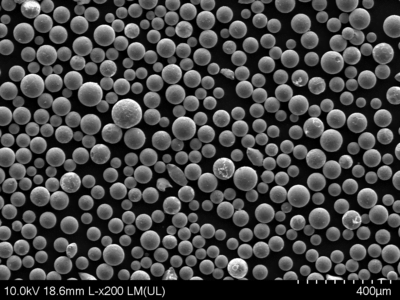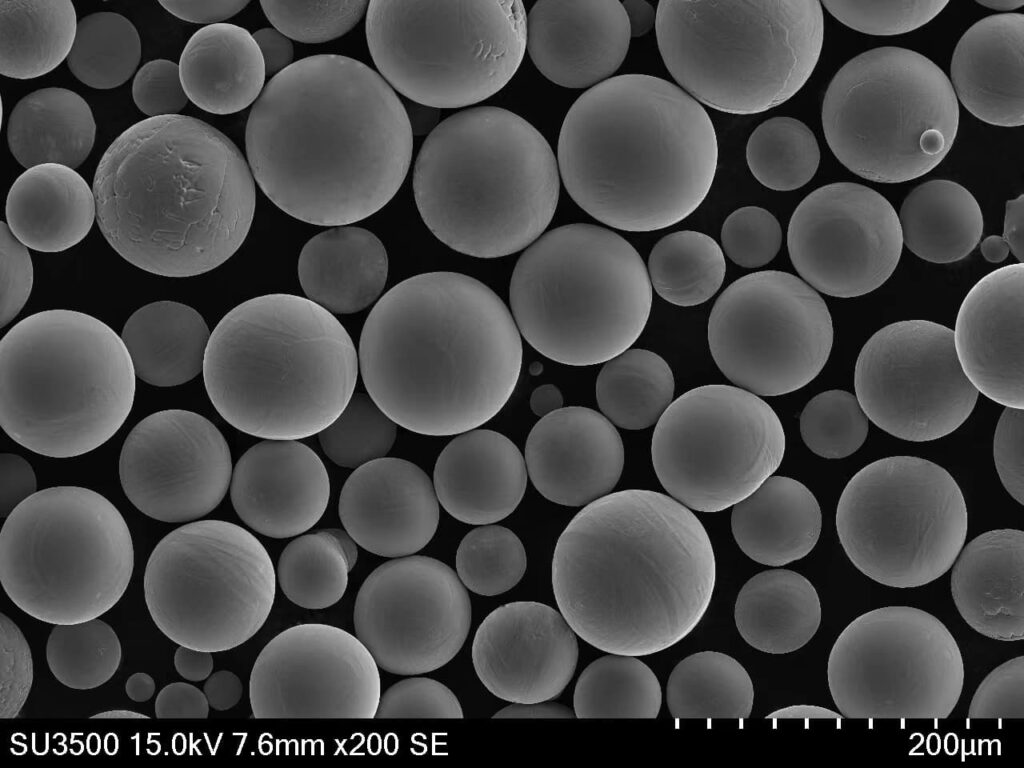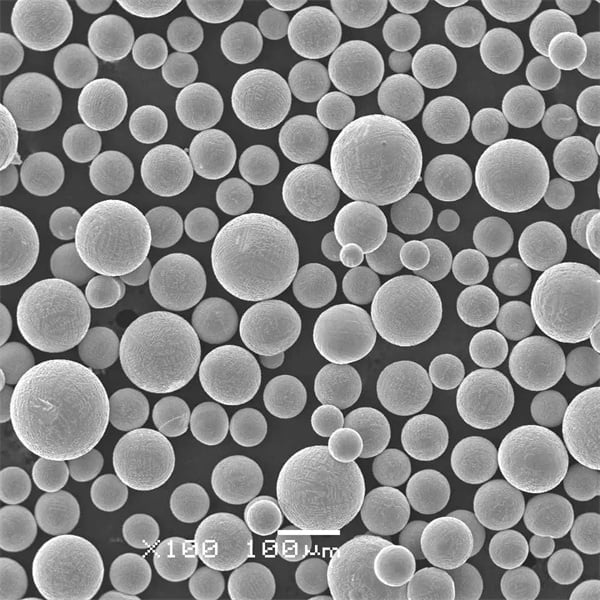Metal 3D printing is revolutionizing the manufacturing industry, offering unprecedented flexibility, speed, and precision. At the heart of this innovation is metal 3D printing powder, the raw material that makes these advancements possible. This comprehensive guide delves into the intricacies of metal 3D printing powder, from its various types to its numerous applications, and everything in between.
Overview of Metal 3D Printing Powder
Metal 3D printing powder is a finely powdered metal used as the raw material in additive manufacturing processes. These powders are specifically designed for use in various 3D printing technologies such as Selective Laser Melting (SLM), Direct Metal Laser Sintering (DMLS), and Electron Beam Melting (EBM). The quality and properties of the metal powder directly influence the strength, precision, and durability of the printed parts.
Key Types of Metal 3D Printing Powders
| Type of Powder | องค์ประกอบ | คุณสมบัติ | ลักษณะเฉพาะ |
|---|---|---|---|
| สเตนเลสสตีล | Fe, Cr, Ni, Mo | High strength, corrosion-resistant | Ideal for medical and food industry |
| ไทเทเนียม | คุณ | Lightweight, high strength | Used in aerospace and medical implants |
| อลูมิเนียม | Al, Si, Mg | Lightweight, good thermal properties | Suitable for automotive and aerospace |
| Inconel | Ni, Cr, Fe, Mo | High temperature and oxidation resistance | Perfect for aerospace and gas turbines |
| Cobalt-Chrome | Co, Cr | High wear and corrosion resistance | Used in dental and medical applications |
| Tool Steel | Fe, Cr, V, Mo | High hardness and wear resistance | Ideal for tooling and molds |
| ทองแดง | ทองแดง | การนำความร้อนและไฟฟ้าที่ดีเยี่ยม | Used in electronics and thermal applications |
| Nickel Alloy | Ni, Cr, Mo | High strength and oxidation resistance | Used in harsh environments |
| Maraging Steel | Fe, Ni, Co, Mo | Ultra-high strength, good toughness | Used in tooling and high-stress applications |
| ทังสเตน | W | High density, high melting point | Used in high-temperature environments |

Applications of Metal 3D Printing Powder
Metal 3D printing powder is utilized across various industries due to its versatility and the advanced capabilities it brings to manufacturing. Below is a detailed look at the applications in different sectors:
| อุตสาหกรรม | แอปพลิเคชัน | ประโยชน์ |
|---|---|---|
| อวกาศ | Turbine blades, engine parts | Lightweight, high strength |
| ยานยนต์ | Engine components, custom parts | Reduced weight, increased efficiency |
| แพทย์ | Implants, prosthetics, surgical tools | Biocompatibility, customization |
| Dental | Crowns, bridges, dental implants | High precision, patient-specific |
| เครื่องมือ | Molds, dies, cutting tools | Durability, precise tolerances |
| เครื่องใช้ไฟฟ้า | Heat sinks, conductive components | Excellent thermal/electrical properties |
| พลังงาน | Turbine components, heat exchangers | High temperature resistance |
| เครื่องประดับ | Custom and intricate designs | Fine detail, complex geometries |
| สินค้าอุปโภคบริโภค | Customizable products | Personalized, unique designs |
| อุตสาหกรรม | Prototypes, functional parts | Rapid production, cost-effective |
Specifications, Sizes, Grades, Standards
When selecting metal 3D printing powders, it’s crucial to consider specifications, sizes, grades, and standards to ensure optimal performance and compatibility with your 3D printing system.
| แบบผง | Particle Size Range (µm) | เกรด | มาตรฐาน |
|---|---|---|---|
| สเตนเลสสตีล | 15-45 | 316L, 17-4PH | ASTM F138, F139 |
| ไทเทเนียม | 20-50 | Ti6Al4V | ASTM F2924, F3001 |
| อลูมิเนียม | 20-60 | AlSi10Mg | ISO 3522, ASTM F3318 |
| Inconel | 15-45 | 625, 718 | ASTM F3055, F3056 |
| Cobalt-Chrome | 10-45 | CoCrMo | ASTM F75, F1537 |
| Tool Steel | 20-53 | H13, D2 | ASTM A681 |
| ทองแดง | 15-45 | C18150 | ASTM B216 |
| Nickel Alloy | 15-45 | NiCr | ASTM F3055, F3056 |
| Maraging Steel | 15-45 | 18Ni300 | AMS 6521, ASTM A538 |
| ทังสเตน | 10-45 | W | ASTM B777, B702 |
Suppliers and Pricing Details
Selecting a reliable supplier for metal 3D printing powder is essential for ensuring quality and consistency. Here are some notable suppliers and their pricing details:
| ซัพพลายเออร์ | Powder Types | Price Range (per kg) | Contact |
|---|---|---|---|
| Höganäs | Stainless Steel, Titanium, Nickel | $50 – $150 | Höganäs |
| แชนด์วิค | Tool Steel, Cobalt-Chrome, Inconel | $100 – $300 | แชนด์วิค |
| เทคโนโลยี LPW | Aluminum, Maraging Steel, Copper | $70 – $200 | เทคโนโลยี LPW |
| Carpenter | Nickel Alloys, Titanium, Steel | $80 – $250 | Carpenter |
| GKN Additive | Various Metals | $60 – $220 | GKN Additive |






Advantages of Metal 3D Printing Powder
Metal 3D printing powder offers numerous advantages, making it a preferred choice in various industries.
Key Advantages
- High Precision and Detail: Metal 3D printing allows for the creation of highly detailed and complex geometries that are difficult or impossible to achieve with traditional manufacturing methods.
- Material Efficiency: Additive manufacturing uses only the material necessary to create a part, reducing waste compared to subtractive methods like machining.
- Customization: Each part can be tailored to specific requirements, ideal for medical implants, dental products, and custom components.
- Rapid Prototyping: Quick production of prototypes accelerates the design and testing phases, shortening the product development cycle.
- Strong and Durable Parts: The resulting parts exhibit excellent mechanical properties, suitable for high-stress and high-performance applications.
- Reduced Lead Times: On-demand production reduces the need for inventory and lowers lead times for critical components.
- Lightweight Structures: Advanced design capabilities enable the creation of lightweight structures without compromising strength, crucial for aerospace and automotive applications.
Disadvantages of Metal 3D Printing Powder
Despite its many benefits, metal 3D printing powder has some drawbacks that need to be considered.
Key Disadvantages
- High Cost: The initial investment in 3D printing technology and high-quality metal powders can be significant.
- Post-Processing Requirements: Parts often require additional finishing processes such as heat treatment, surface finishing, or machining to achieve desired properties.
- Limited Material Selection: Not all metals are suitable for 3D printing, and the range of available powders is more limited compared to traditional manufacturing materials.
- Print Speed: The process can be slower than some traditional manufacturing methods, particularly for large or complex parts.
- Quality Control: Ensuring consistent quality can be challenging, requiring stringent process controls and testing.
- Environmental and Health Concerns: Handling metal powders can pose health risks, necessitating proper safety measures and equipment to protect workers.
Comparison of Metal 3D Printing Powders
To aid in selecting the right metal powder for your application, here’s a comparison of some popular options:
| Metal Powder | ข้อได้เปรียบ | ข้อเสีย | Best For |
|---|---|---|---|
| สเตนเลสสตีล | Corrosion-resistant, strong, versatile | Heavier compared to some metals | Medical, food industry, general engineering |
| ไทเทเนียม | Lightweight, high strength, biocompatible | Expensive, challenging to process | Aerospace, medical implants |
| อลูมิเนียม | Lightweight, good thermal properties | Lower strength than some alternatives | Automotive, aerospace |
| Inconel | High temperature and oxidation resistance | Expensive, difficult to machine | Aerospace, gas turbines |
| Cobalt-Chrome | High wear and corrosion resistance | Expensive, brittle | Dental, medical |
| Tool Steel | High hardness, wear resistance | Prone to cracking during printing | Tooling, molds |
| ทองแดง | Excellent thermal/electrical conductivity | Susceptible to oxidation | Electronics, thermal management |
| Nickel Alloy | High strength, oxidation resistance | Expensive, difficult to process | Harsh environments |
| Maraging Steel | Ultra-high strength, good toughness | High cost, complex heat treatment required | Tooling, high-stress applications |
| ทังสเตน | High density, high melting point | Extremely heavy, difficult to process | High-temperature applications |

คำถามพบบ่อย
Q: What is the most common metal powder used in 3D printing?
A: Stainless steel is one of the most commonly used metal powders in 3D printing due to its versatility, strength, and corrosion resistance. It’s widely used in various industries, including medical, food, and general engineering.
Q: How is the quality of metal 3D printing powder controlled?
A: The quality of metal 3D printing powder is controlled through rigorous testing and standards. Factors such as particle size distribution, morphology, chemical composition, and flowability are critical parameters that are monitored to ensure consistent quality and performance.
Q: Can metal 3D printed parts be as strong as traditionally manufactured parts?
A: Yes, metal 3D printed parts can be as strong, if not stronger, than traditionally manufactured parts. The layer-by-layer construction allows for the creation of complex internal structures that can enhance strength and reduce weight.
Q: What are the safety considerations when handling metal 3D printing powders?
A: Handling metal 3D printing powders requires appropriate safety measures to prevent inhalation or contact with the fine particles. Personal protective equipment (PPE) such as gloves, masks, and protective clothing, along with proper ventilation and dust collection systems, are essential for safe handling.
Q: How does the cost of metal 3D printing compare to traditional manufacturing?
A: The cost of metal 3D printing can be higher than traditional manufacturing methods due to the cost of equipment and metal powders. However, the ability to produce complex, custom parts with minimal waste and shorter lead times can offset these costs, especially for low-volume or highly specialized applications.
Q: Can any metal be used for 3D printing?
A: Not all metals are suitable for 3D printing. The material must be available in a fine powder form and have properties that allow it to be melted and fused layer by layer. Common metals include stainless steel, titanium, aluminum, cobalt-chrome, and nickel alloys.
Q: What post-processing steps are required for metal 3D printed parts?
A: Post-processing steps for metal 3D printed parts can include heat treatment to relieve stresses and improve mechanical properties, surface finishing to achieve the desired smoothness and appearance, and machining to achieve precise tolerances and features.
Q: How does metal 3D printing impact environmental sustainability?
A: Metal 3D printing can be more environmentally sustainable compared to traditional manufacturing methods due to its material efficiency, reducing waste, and enabling the recycling of unused powder. However, the energy consumption of the 3D printing process and the production of metal powders can impact overall sustainability.
Q: What industries benefit the most from metal 3D printing?
A: Industries that benefit the most from metal 3D printing include aerospace, automotive, medical, dental, tooling, and electronics. These industries require high precision, customization, and the ability to produce complex geometries that are difficult or impossible with traditional manufacturing methods.
Q: What advancements are expected in the future of metal 3D printing powders?
A: Future advancements in metal 3D printing powders may include the development of new alloys with enhanced properties, improved powder production techniques to reduce costs, and advancements in 3D printing technology that increase speed, precision, and material efficiency. Enhanced recycling and sustainability practices are also expected to play a significant role in the future of metal 3D printing.
บทสรุป
Metal 3D printing powder is transforming the manufacturing landscape, enabling the production of complex, high-performance parts across various industries. Understanding the different types of metal powders, their properties, applications, and limitations is crucial for selecting the right material for your specific needs. As technology advances and new materials are developed, the potential of metal 3D printing will continue to expand, offering even greater opportunities for innovation and efficiency.
About 3DP mETAL
Product Category
ติดต่อเรา
มีคำถามอะไรไหม? ส่งข้อความมาเดี๋ยวนี้! หลังจากที่ได้รับข้อความแล้ว เราจะประมวลผลคำขอของคุณพร้อมทีมงานทั้งหมด
